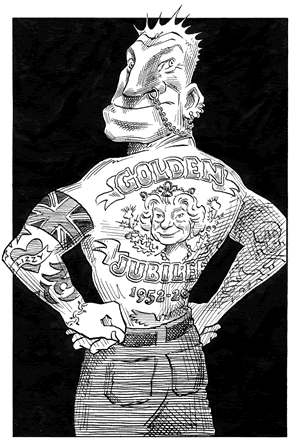- International Affairs
- Law & Policy
- Civil Rights & Race
 |
| Illustration by Taylor Jones for the Hoover Digest.
|
LONDON—For several days in June Britons took part in the world’s biggest garden party in honor of Queen Elizabeth’s Golden Jubilee. Bonfires were lit across the country; flags and bunting festooned houses and streets; services of thanksgiving were held in churches and cathedrals; and two great open-air concerts—one pop with Paul McCartney, one classical with Rostropovich—were held in a Buckingham Palace thrown open for these musical picnics. Even the famously countercultural Ozzy Osbourne was among those serenading Her Majesty in honor of her 50 glorious years.
Yet, only a year ago, the conventional wisdom was that the Golden Jubilee was likely to be a frowsty and embarrassingly ill-attended affair.
Republican sentiment was said to be on the rise; young people were allegedly turned off by royal flummery; the magic of monarchy had been rubbed off by the soap-opera antics of the younger royals; and Princess Di’s death had supposedly revealed an ominous gulf between the emotionally open New Britain and the emotionally frozen Windsors. My old college friend Stephen Haseler, author of various books on political theory and now improbably Britain’s leading republican, has assured me repeatedly that the monarchy had only a few years left. The queen would go down in history as Elizabeth the Last.
Princess Margaret’s funeral seemed to confirm this analysis. It aroused little public mourning. But the death of the Queen Mother a few weeks later produced an upsurge of national grief and patriotic nostalgia.
In both cases the explanation was the same: Princess Margaret went unmourned because people felt, however unfairly, that she had not repaid her privileges with a life of service; the Queen Mother was seen as devoted to her country (while also being human enough to enjoy racing and her daily tipple of gin).
As even her republican detractors concede, Elizabeth II passes the test of service with flying colors. One moving moment occurred during the Buckingham Palace classical concert. As a patriotic hymn was being played, the giant television screens showed a series of photographs taking the queen from the young princess of the 1930s to the matriarch of today. All of them, while conveying the passage of the years, also showed a seriousness of purpose in her features from start to finish. It is not too much to say that Elizabeth Windsor is the personification of duty.
Upholding the ideals of service and duty is one of three purposes of a constitutional monarchy. All nations need an ethic of public service to temper and offset the culture of economic success that would otherwise dominate social life, making it cruder and greedier. The queen sits on the top of the British pyramid of public service, and twice yearly she gives honors to people as various as voluntary social workers, distinguished artists, and industrialists who have given generously to charity. There are hypocrisies embedded in the honors system, of course—the government’s friends benefit disproportionately “for political services”—but in general it reminds us all, including the successful, that there is more to the good life than getting and spending.
The second great purpose of the monarchy is to be available as an impartial umpire above party when the nation is split by a constitutional crisis. The queen’s impartiality is established by the testimony of all her prime ministers from Churchill to Blair. And the evidence for her success is that since 1952 Britain has had many political crises but none has grown to the point of threatening its constitutional order.
The third function of the monarchy is to provide a visible expression of the nation—thereby to sustain its links with past and future and to help it overcome the stresses of change. Britain has changed substantially in the last 50 years—going from a semi-socialist welfare state to a thriving market economy but also seeing its power reduced as the British Empire became a commonwealth of independent states. Much of the credit for the nation’s stability through these upheavals must go to the queen—in particular to her fostering of friendly and cooperative relationships between Britain and its former colonies through countless Commonwealth tours.
Faced with these achievements, a principled republican will reply that they do not compensate for the fact that even a constitutional monarchy with very limited powers rests on the irrational hereditary principle. A principled monarchist might respond that it is equally irrational to expect a partisan politician running for election to provide a focus for national unity—though the U.S. president does exactly that.
All constitutions have their irrationalities born of history. And their occasional failures too—Nixon and Edward VIII come to mind. What matters is whether they provide good government, which in these times means liberal and democratic government. Neither the British constitutional monarchy nor the U.S. republican constitution has succumbed to the political extremes of continental Europe, whether fascism or communism, because they are supported and restrained by long and influential constitutional traditions. The British constitution dates from 1688; the U.S. Constitution from 1789; and the French constitution from 1958. Longevity itself is a virtue in constitutional affairs. And over the centuries the two Anglo-American traditions have learned to cope with and accommodate all manner of challenges in all manner of ways.
So it would not surprise me if some years hence I picked up a newspaper to read that the queen made a gesture toward accommodating her critics by giving my old friend a suitable “gong”—Professor Stephen Haseler, Knight Commander of the Order of the British Empire, for Services to Republicanism.







